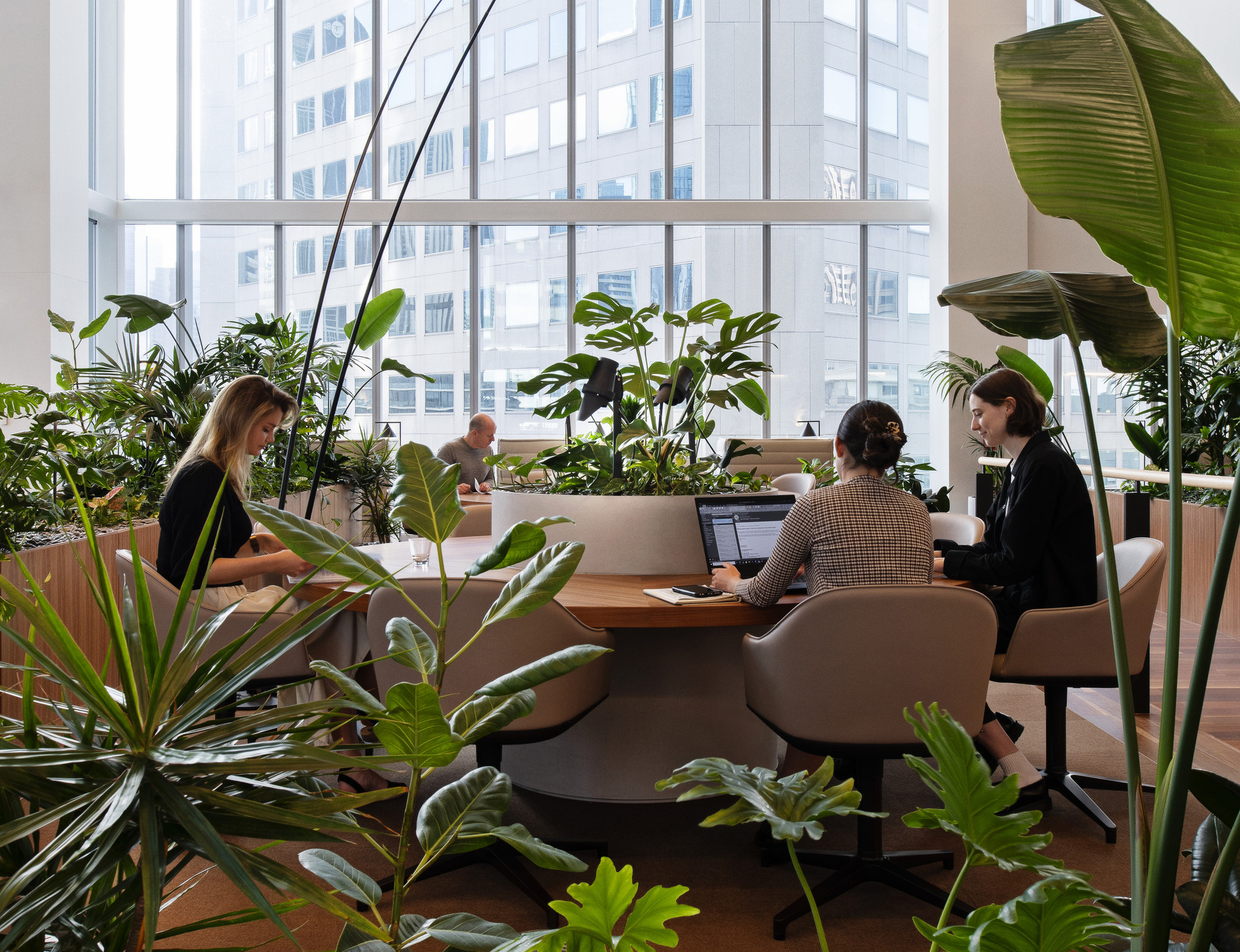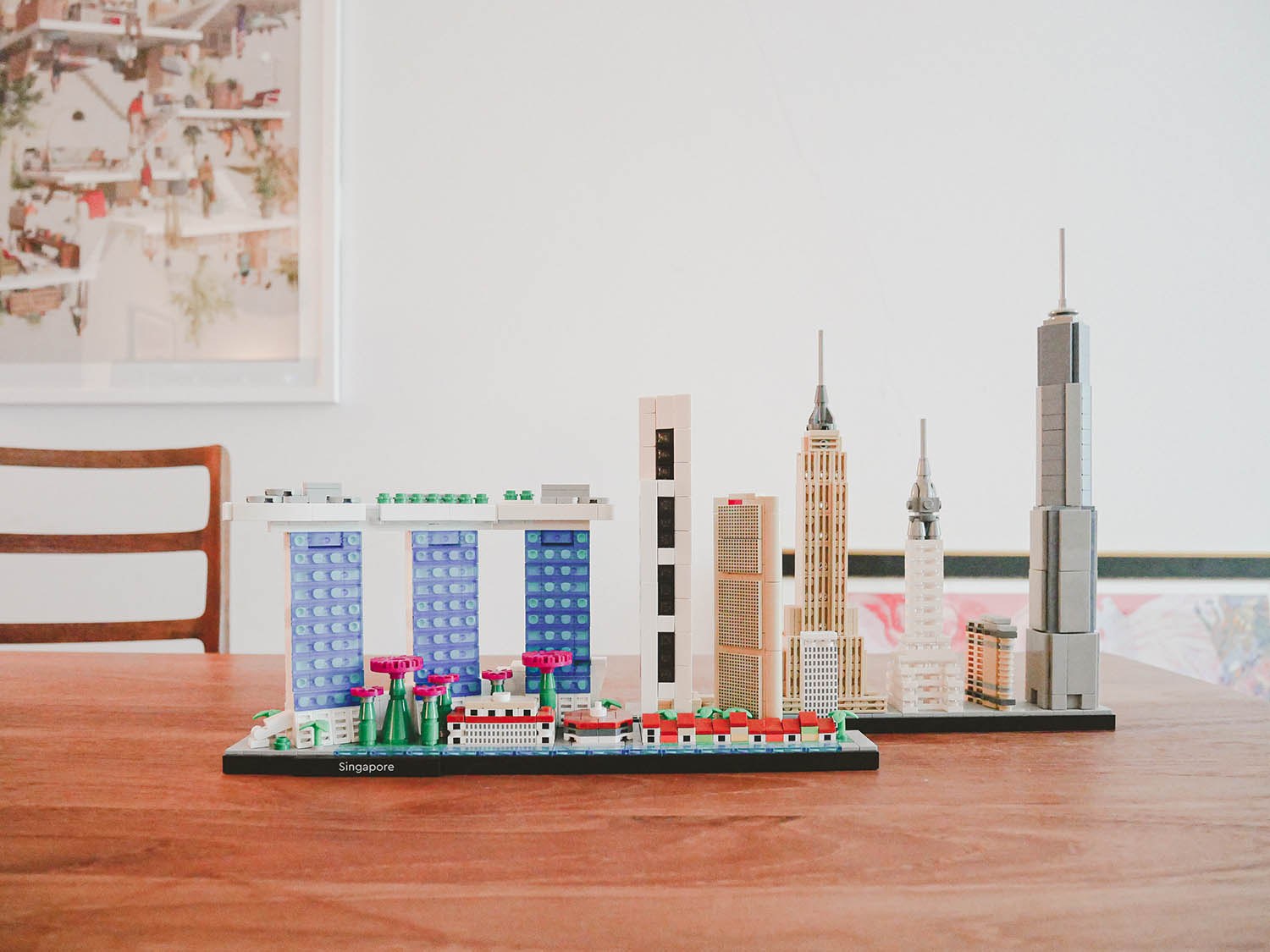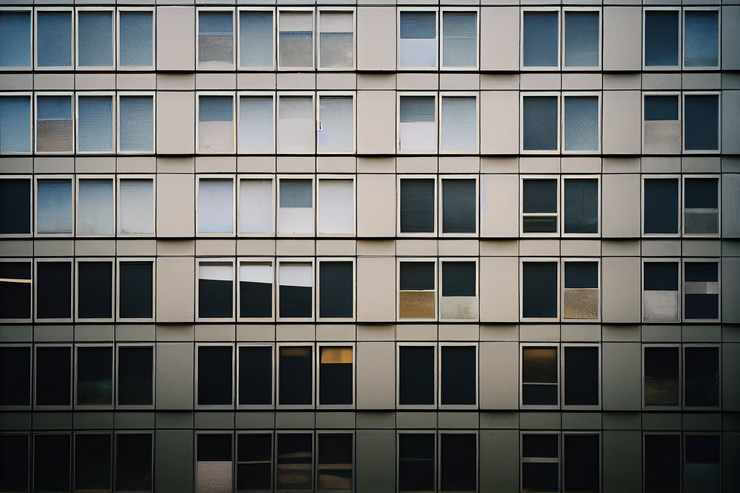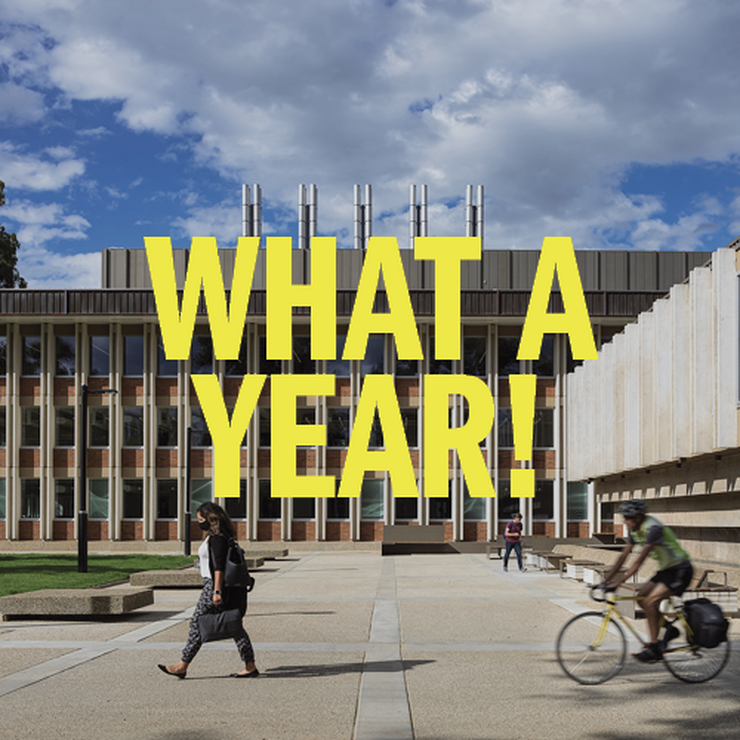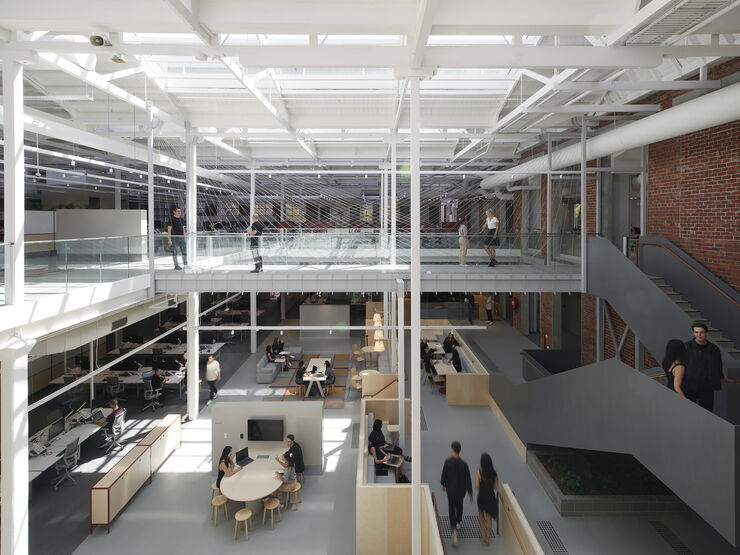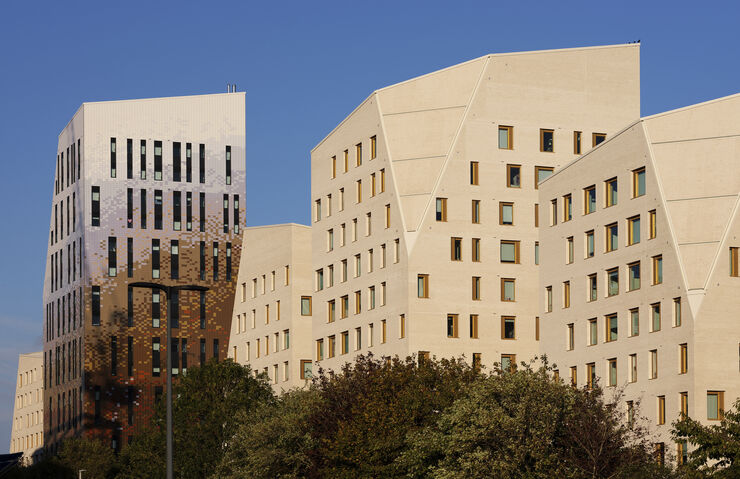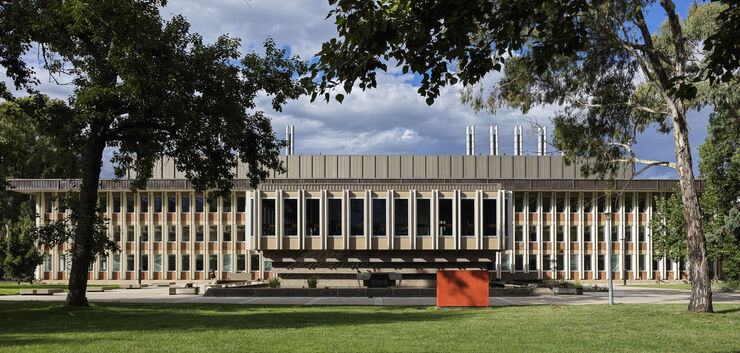Transcript
Razvan I. Ghilic-Micu begins talking
Hi, I’m architect Razvan Ghilic-Micu and you are listening to Hassell Talks. Welcome back.
At Hassell, I work in the Singapore studio, a country where I’ve lived and practised for a decade now, but this is only one of the many different hats I’m typically wearing. Outside of practise, I’m the chief editor of Singapore Architect Magazine and in 2021, I had the privilege of leading Archifest, Singapore’s Annual Architecture Festival. Whether as a practitioner, editor, or festival director, I have witnessed a wide variety of topics come and go over the past few years.
But there is one topic that started bubbling up more and more with every conversation, gathering momentum and showing great potential to become a real global movement. The topic of adaptive reuse at an unprecedented scale. In conversation with local and global clients, I debated the tension between creating a new iconic building, the kind it takes 10 years to achieve, or a different route, that of regenerating an already existing generic building. Our cities are full of such unremarkable structures quietly fulfilling their function under the radar every day. Not making the best of them just feels like such a missed opportunity.
In March 2023, the Green Building Council of Australia’s Transformed Conference brought together a diversity of like-minded professionals, passionate about sustainability and the built environment for a great event in Sydney on Gadigal Country. We have added a link in the show notes so you can see the wide variety of topics covered at the conference.
My colleague Samantha Peart, who is Hassell’s head of sustainability and I were asked to share with the audience at Transform our ideas of shifting our cities toward renewal and turn today’s ordinary spaces into tomorrow’s extraordinary places. Many thanks to the team at the Green Building Council of Australia for the recording. I’m really glad we are able to share this recording with you, and I hope you enjoy it.
Audience clapping fades in and out.
Razvan Ghilic-Micu begins speaking, this time to an audience at the Transform conference:
Maybe I will start by sharing a bit of an unexpected social experiment that happened a week ago in Singapore when I was telling my friends that I’m coming to your lovely city.
And of course, I’m an architect. Most of my friends are architects and they started telling me about all the places I should see, all the wonderful buildings. And I’m pretty sure that if we did a bit of a poll today in the room, we might come up with the same short list, very short list of iconic buildings. Which brings me to the big question I want to open with, which is why are we so obsessed with iconic architecture?
And look, far for me to dismiss it. I mean, I do understand and I do believe also that it plays a very important role as a social, as a cultural bellwether. It embodies our hopes and aspirations as people and also quality that we all try to aspire towards, but there’s something really odd about the reductive identity of our cities and of our buildings when you see them represented on postcards and on keychains at the airport and on lapel pins, not to mention Lego sets like the one behind me. (Shows slide of a LEGO Singapore) And it’s actually … I own them and I took this photo on my dining room table last week in Singapore. Maybe it’s a good thing to say that Lego is not sponsoring me. These are gifts for my lovely sister. I’m very proud of them, but what I felt even more fascinating than this is when I was fiddling with Midjourney AI, and I’m sure you’ve heard of it and I’m sure some of you or most of you have played with it as well, it seems to have the same notion about what is iconic and what is generic when it comes to buildings.
It’s probably just further proof that it’s database of billions of inputs reinforce our collective bias. And these two images came out when I was typing in the inputs that you can see at the bottom of the screen. Iconic architecture in Singapore. I’m sure you can recognise it from the Lego set, and generic boring architecture in Singapore. And to make it all even more entertaining and confusing, once I refreshed the prompt a few times, I got something that is clearly no longer in Marina Bay. And you might have seen this building, I don’t know, in a city near you, but today I am here not to talk about that, but really focus on the fictional building on the right-hand side of the slide and the many buildings around the world that look just like it. And to put things in a perspective, I think I wanted first to acknowledge a cultural blind spot that we have all been sharing around the world for the past, let’s say 60 years or so.
I believe we have yet to fully come to terms with a real impact of building a new iconic building, especially in the petrochemical economy framework of design and of procurement that I know a lot of you are experts in, which is so deep-seated in the way that we are trained, we have been trained, and the way that many people still choose to practise. In this fantastic book, and I fully recommend it, Unless by Kiel Moe he quantifies and analyses the impact of the Seagram building and all the different design decisions made. Did you know that Mies van der Rohe’s signature bronze mullions account for about 1.8% of the building mass, but 47% of its ‘emergy’(sic)? And that’s not a typo. It is a term used by late ecologist Howard T. Odom to measure the amount of energy depleted in ecosystems to create materials. So his analysis provides really good data about the materials and energy consumed when making this building.
And I guess for me, one of the most evocative drawings is this scale diagram that is showing the Seagram building’s height. And you can see it really small, dwarfed at the end of the slide by the mountain of resources that went into making it, into building it. This iconic building is not just one of the most expensive buildings of its time, but its cost has been underwritten at a planetary timescale. And speaking of time, I think time is perhaps one of the most essential ingredients when it comes to regenerative development. There’s no such a thing as instant sustainability. As you all know, carbon and energy are long-term investments. And I was really happy to see my old grad school classmate, Brandon Clifford, who now runs the master of architecture at MIT, writing this amazing, really delicious, funny book, Cannibal’s Cookbook. And the book is looking at ways in which historically human habitation has relied for thousands of years on a diet consisting of its own old buildings.
Adaptive reuse for its longest time has been our norm, that until industrialization, when producing and tearing down millions of buildings has accelerated. And what it did, it created a massive stock of generic, ordinary structures that quietly fulfil their function under our radar. This is our modern day heritage, by the way. These are buildings that most of us work, live, learn, and play in, places that we’ve walked by every day on our way to work, back from lunch, and we never think twice about, ordinary places that get pulled down every time the plot ratio goes up. Why don’t we talk more about them? What would our cities really look like if these buildings that command 90% of our collective real estate were improved? And I think some of the work that our hassle team has been doing here in Sydney is starting to show the potential of meaningful intervention, from the scale of the city down to that of an interior, because in reality, in most markets, 80% of the buildings that will be around in 2050 have already been built.
Now anecdotally, 2050 is about when I should be retiring, so I think my generation should dedicate our smarts and the rest of our careers to really building on what has already been built. So what drives change? I know it’s easier said than done. Obviously a major influencer is policy, food policy. In Singapore we are fortunate because the URA has been skillfully planning that island for the past 50 odd years and planning it. There’s a long-term plan happening into the next half century and beyond. And these incentives were passed back in 2019, but they were all put in place in the CBD for five years only to ensure that we bring quality places and people back to the city. And these are critical, without which it will be really impossible to move the needle and help people change their habits, because frankly, we’ve been doing this all along.
I mean, all building owners constantly fix their buildings one way or another, but the problem is that either through lack of incentives or lack of business creativity, it’s all been part of a well-oiled process of upgrading the minimal baseline, or just enough to flip the property for a profit. And I’m not here to pontificate and critique the business as usual, because we all want great lifts and we all want fast wifi, but I have to a ask myself, as a designer, as an everyday citizen, does it do anything more than just keep the building serviceable? And the cracks are already showing. I mean, here you can see a cloud of concerns that were generously and candidly shared by some of our clients. And I’m pretty sure that you will find some that resonate with you or some that you have heard yourselves. And I won’t dwell too much on this slide because the only way forward from here is to recalibrate our approach.
Quality is all relative to the expectation bar, and that’s constantly moving up. And everything that you’ve seen a few slides ago, the business as usual, is right there below that bar. We expect lifts to work. We expect wifi. We want a building that’s maintained. There’s nothing new about that. Does it make it a better place? Probably not. The way out of our ruts towards better buildings and better cities is all about investing and going above and beyond that bar. Redefine your new normal, redefine your aspirations. This is how buildings acquire exceptional relevance over time, but also increase value. This is what turns today’s ordinary spaces into tomorrow’s extraordinary places. And this is where great design comes in. In a world filled with uncertainty, business as usual won’t make a difference, but creativity and insight will.
So what are some of the key ingredients to extraordinary places? Well, maybe first you should ask yourself, are you being a good host? Who is frequenting your building and its amenities? What’s the footfall and demographic of your tenants, of your workforce, of people who come in and out, the visitors to the building? And look, if you don’t know, that’s okay. We have big data. At Hassell, we work quite frequently with our partners from Place Intelligence to create great places with purpose and really understand the footfall, the neighbourhood, who comes in and out of the building, how we can cater and tweak and fine tune the place for those people. How do you attract new people to the building? And once you host them and you have them there, how do you then expand it to create community and belonging? I mean, at the end of the day, that’s what we want. We want to belong. We want to be a part of something.
And are you playing to your strengths? This is where design strategy starts to kick in. Matching your floor plate configurations to the right type of businesses will allow you to focus on the right audience, but also maximise the performance for the right culture. One size doesn’t fit all. And if you do take that approach, sometimes you can achieve a lot more with a lot less if you get your strategy right. And behind me you can see the purpose-built headquarters we did for a pharma giant, GSK, in Singapore. What you cannot see in the image is that we made the building actually a little bit smaller in order to bring to life three heritage black and white bungalows behind it and create an ecosystem. Before we even put pen to paper, we really looked at the strategy of what GSK was aspiring towards as a company for the future.
And that doesn’t need to be just, I guess, the privilege of new buildings. Innovation doesn’t mean new build. For most buildings, the primary structural systems, the beams, the columns, the floor slants, they have most of the embodied energy. And look, in a climate like the harsh tropical one in Singapore, they tend to outlast the façade a lot more. So a well-designed reclad of a building will dramatically extend its lifespan, its relevance, while it also minimises the overall embodied carbon and future energy consumption. And in time … we come back to the concept of time … the cost reductions will show up as the building performance is being optimised. So these changes will make the investment not only worthwhile, but gives it that time to become measurable and lasting as a good impact for renewal. One of my favourites, green it like you mean it … I like a good rhyme.
Coming from Singapore, where if you put a broomstick in the ground in the evening, you’ll see flower growing out of it the next morning, doing greenery is so easy that it’s no longer enough. You have to do it in a meaningful way, not just for the sake of it. And holistic biophilia, and we’ve heard a lot this morning about it, is more than just planting. As the science of sustainability and carbon and energy evolves, the world is moving away from decorative images of buildings with plants and trees on them, which are lovely, but they’re moving towards a more performance based approach to building an ecosystem. And a lot of these high performance solutions are most often more than skin deep. And again, what we did at GSK is create spaces that are not just token outdoor terraces that no one uses, but by creating shelter, by moving the air, by getting evaporative cooling at skin level. They are real external workplaces that people are looking for throughout the day.
And to zoom back out to city scale, no building is an island, as we all know. Being a good neighbour means adding to your context and knowing how to leverage it and interface with the urban fabric around you in a very conducive and welcoming way. Creating that recognisable meeting point for the rest of the neighbourhood and finding ways to build an urban and a street level that is active and invites people into your lobbies can transform an ordinary building into a destination and a really key part of your community, because essentially, if you think about it, building thriving communities is all about creating places people love, which is our mission at Hassell. And if you want to delight your existing community and attract new friends, having that address is not enough. You can think of a strategic café, great meeting spaces, collaborative areas, even wellness focused environments will turn a transient experience into a place of belonging. They build trust and they encourage your community to form and to thrive. This would be good for your building and definitely much better for your cities.
So in closing, the climate emergency makes it a must for all of us to curb carbon emissions on all of our projects starting now. Change is coming, I think faster than we all anticipated. And the cost of doing nothing or doing too little is greater than ever. And what I would like to encourage all of you, all of us, and maybe challenge you is to become early movers in that space if you care about your relevance. Don’t wait for someone else to try it first. If the framework or the system or the funding or the incentives are not ideal, well when are they ever? Make them happen. Change the system. It is our collective responsibility to turn ordinary places and spaces of today into the extraordinary of tomorrow with our wit and our knowledge and by collaborating, and that will become our legacy and our new [inaudible 00:13:44]. So on that … nope, I will join Sam right over there. I look forward to a chat with her, but feel free to browse the paper and many other goodies on the Hassell website. Thank you.
Samantha Peart beings speaking, also at the Transform conference:
Thank you so much, Raz, for coming over and sharing this with us. And I was really excited when you agreed to do this, because it is a different lens. And I’ve worked in engineering, I’ve worked in consulting, I’ve worked in development, I’ve worked in government, and recently and very kindly been invited into the world of design with Hassell. It’s given me another perspective in tackling the big issues we’re all here to talk about, which is great and exciting because, as Raz said, we do all have a role to play. I think the world of existing buildings is really an interesting space, because the maintenance piece that Razvan talked about, we are all really familiar with that. We’re familiar with how it impacts operational carbon.
We’ve also heard a lot about embodied carbon in the last couple of days and how revitalization of existing assets is key, given kind of the carbon that has underwritten the development of those assets. So a lot of your, I guess best part of the diagram there, Raz, showed your six ingredients, but they’re not explicitly focused on carbon. I think you mentioned carbon once or twice in those. So what are the drivers beyond carbon that you are seeing on the ground from asset owners and people who occupy these existing places and spaces?
Razvan responds to Samantha:
That is a great question. Thanks for that, Sam. Honestly, I think that obviously carbon and energy and cost and time are really good at framing, I guess the issue, because they’re quantifiable. I’m not saying they’re easy to solve, but they’re easy to frame. And there’s a lot of focus going on that because you can implement what you can measure and you can measure what you implement. And what I think we can all see over the past five to 10 years is a bit of an awakening to authenticity that a lot of us are experiencing. I mean, think of how many times you turn a bag of something that you buy to see sort of the nutritional facts on the back. People are starting to do that with the buildings and with their workplaces and with their organisations.
And again, carbon and things you can quantify are only one half or less of that question. The other half is the unquantifiable. And I don’t remember exactly the source, but I was listening to a lecture and the speaker was talking about how at the end of the day we are emotional beings, and a lot of the decisions that we make when it comes to purchasing and who are our friends and what brands we align ourselves with are not about the speed of the processor but about the lifestyle it enables. It happens in the limbic brain and it’s highly emotional. And you can see that happening in buildings, where people no longer have to go to work, they have to want to go to work. They no longer have to be anywhere, they should want to be at that place.
And that’s where I guess the emotional, mental value alignment comes in. And I know it’s scary because it’s bloody hard to quantify. It’s all about quality. So the answer is … and the reason why I didn’t focus so much on carbon, although I deeply care about it, is that we have so many brains in this room who know that stuff way better than I, so I’m trying not to look too silly in front of them, but in reality you need both and you shouldn’t think either/or. I think binary thinking has gotten us to where we are. I think disclaiming because of a spreadsheet got us to where we are. And I think the way forward, and when you were talking about … I’m not talking about compromise, but when you were talking about setting priorities, it should really start to look at the things that cannot be quantified.
And maybe I’ll just say one last thing before getting your reaction on that, is design in its kind of nature and how we work, it’s highly unpredictable because we deal with unpredictable inputs. And that is confronting. It’s really scary, but I think that’s the role of the designer and that’s why I’m really happy to be in this crowd today, is to advocate for some of the cross pollination that needs to happen between fact and interpretation, between tangible and intangible, between quantifiable and qualifiable. And I think that’s where you can see communities. The SG in ESG, everyone’s struggling with it because it’s pretty hard to put kind of numbers on it other than, “Oh, I’ve done three events.”
Samantha comments:
We are doing a project at the moment in Vancouver where the building owner … there’s a set of two buildings in the city, and the building owner has spent 10 years investing in getting it to a equivalent to essentially six of our neighbours. It’s an amazing programme. And for me I’m like, “Cool, what else do you do?” Coming from a different background, this is my first introduction to being in the design space.
We’re doing a master plan for the redevelopment of the experience of that building to make it competitive in a market where new buildings are coming up around it. And I kind of wanted you to talk a little bit more then about how you see the role of design interacting with the deep industry expertise that already exists, a lot of it in this room, around financing, engineering, and body carbon to focus on the stuff we already have and creating that demand through experience to evolve our cities into places where people and nature thrive together.
Razvan responds to Samantha’s question:
All right, I guess maybe I’ll volunteer that little bit of personal info, which is I do have stressful hobbies outside of my day job, and one of them two years back was being the festival director for Archifest, Singapore’s architectural festival. And the topic I said for that one is design evidence. And it was on purpose, because representing the architectural community in many ways, I can hear a lot of anxiety that designers have, looking at how other professions much more specialised, much more valued in the whole kind of ecosystem of the construction industry, are borrowing knowledge and language from design, processes from design. And they feel more and more obsolete. And I try to avoid the term design thinking, because I know everyone must have had a course at one point or another. We kind of call it thinking.
And what I was trying to do is kind of dismantle that reading of it’s us and them, different sides of the table, that it’s sequential, I mean all of that nonsense. And what I was encouraging designers to do is really kind of soul search a little bit and think about is what we do for a living wishful thinking and highly aspirational? Are we able to not steal back, but borrow some of the language, some of the processes, some of the knowledge that you see across the table or around the table from other consultants? And that’s why, I mean you are such a wonderful unicorn, five in one. And I think that is the spirit. At least I don’t want to be doing the same thing for the rest of my days. I love what I’m doing, but I’m hoping I can grow. I’m hoping everyone in this room will do something different next year and in five years and 10 years.
And you’re not going to do it in sort of your echo chamber of your own discipline. It has to be done around the table with others. And what I also see in … again, back to the practitioner hat, of not just us as a practise but also other practises and related industries, it’s starting to not branch out by creating different business lines, because that jargon just is hard, but really understanding how other people work. And I think designers starting to come upstream as well. Back in the day, and I think I was making fun of architects. I can’t because I’m one, saying we’re just like Alexa. We only come to life when someone has a brief for us. But are we part of creating that brief? Are we part of advising? Are we part of strategy? Well we should, not because we’re greedy, but because if you don’t have a kind of brain trust around the table, you might be missing something out. And missing something out breaks me up.
So out of that desire, I think that everyone should have to learn, to branch out, cross pollinate, which is exactly what’s happening today and happened yesterday. I think that that is the future of trans … I’m not even going to call it cross-disciplinary, I’m going to call it transdisciplinary, where it can be both and the other when it comes to your knowledge, what you do, and how you do it, but it’s all driven by a sense of purpose. So we should be less driven by a brief or a contractual kind of to-do list and driven by a shared sense of purpose. And then all the petty things that happen in the life of a project hopefully will go away.
Samantha responds to Razvan:
It’s interesting. So what you’ve just described is exactly what’s happened with our Perth team doing a project with a school, essentially. And instead of the school finding an existing building, because they needed an existing building because no space, instead of going, “Right. We found a building, sort it out for us,” the whole consultant team, not just us, were on board to go and assess existing buildings and what would work based on their needs. So we were actually, all of us together, developing the brief with that school. So we’re turning a commercial building into an inner city school, essentially, which is a really exciting project that we’re all learning from. I’m going to ask you one more before we open it up for heckling, but how does I guess the design process then maybe look different with those six ingredients that you talked about for those existing assets? Is it a different process? So yep, all at the table, brief, good. What about after that?
Razvan responds to Samantha:
Well, for this one I think … I mean in a sense, when it comes to developing a new project, there is a good way of starting that. So you do start at the start line with a to-do list, and ideally you get to implement all of it in a holistic way. Now when it comes to an existing building, the problem is you have pre-existing conditions and you have to give it a thorough … I don’t know why I’m doing medical metaphors, but here we are. You got to give it a thorough physical to understand what’s there. And I think that’s where the whole process … well, I wish I just thought it, but I know it from a project that I’m working on in Singapore currently, that that process is messy and that process requires even more, I guess open, transparent collaboration, because you don’t know what you don’t know.
So in a sense, I think it relates back to your previous question, which is how do you collaborate? And this one, I think it’s also how do you then out of the entire laundry list of due diligence, of professional knowledge, of code that may apply, have the ability to sift through and figure out what’s relevant, what’s irrelevant, what’s a priority, and what isn’t. Now, is it messier? Yes it is. Is it more difficult? Yes, it is, but I believe there are great impacts that will be seen downstream. And I think the notion of time that I spoke about, again, has to be reintroduced here, because things don’t go to plan almost always, but in reality, when you are just kind of going down a straight line, most things will go to plan.
You can kind of stay on course and you might or might not see the benefits once it gets implemented, but for existing buildings we can see the benefits, like suspending your disbelief as the process is messy will start paying back dividends over time. What I don’t see a lot of, unfortunately, is the patience and wisdom to take on perhaps a bigger CapEx, perhaps more risk upfront in order to have the patience to stay with the asset to see it pay back. We’re still in that kind of quick flip mentality. And to paraphrase, kind of quote of friend of mine, he was saying, “If you don’t change the system, you cannot operate within it.” He was saying sustainable buildings are like low tar cigarettes. You think they’re not as bad for you, but they’ll be the same in the end. So the question is if we try to innovate within the same mindset, we’re just kidding ourselves. We have to change that structure.
Samantha comments:
It’s kind like chicken and egg here. So you’re talking about essentially through mixing those six ingredients and thinking beyond the carbon piece and into creating the experience, that then creates the demand. So I guess we are kind of hovering in limbo waiting for one to move. Claire Perry from Development Victoria has sent us here a pretty curly question, which I’m going to throw at you. How far back or how deep into the sector do we need to go to unpack that ego involved in creating new? How do we flip the competition to create pride in doing the best we can with what we have?
Razvan responds:
Thanks Claire. That’s a very good one. It is a very good question. And I think … I mean ego was one. I think also measuring excellence is the other one. And I was really heartened last year to see the building of the year being I guess a poster child for what we’re talking about today. I don’t think we need to go back that much. I think it’s really about understanding what is valuable. And I know that sort of whole cost and value conversation is a pretty heavy one.
And I think once we frame what is valuable … and that’s why I tried a little bit of a slight of hand here with iconicity in the beginning, why are we obsessed with it? And at the end I’m like, “Well, here’s a new way of doing iconicity.” We all want to be proud of what we do for a living. Let’s not get that wrong, but I think if we think of fixing or if we think of working with old buildings as just bandaid, “Oh, I’m just repainting my car hoping it’ll go for another five miles.” It’s not that. Think of it as completely changing. I mean there’s so much pride. I don’t think we’re that far from it.
Samantha says:
But I think what you just touched on there is what is excellence, celebrating excellence.
Razvan agrees:
Right.
Samantha wraps up:
I just wanted to thank you again for coming all this way to spend time with us, because I’m so glad that essentially the rest of this room got to see the excitement and the motivation within the design community to address the issues that we’re all trying to tackle. So thank you very much, Raz.
Razvan responds:
Right on time. Thank you.
Audience clapping fades in and out.
Razvan speaks directly to the podcast listener:
Although the event was held in Sydney, it’s incredible how the conversation really took on a global scale. We were approached afterwards with questions relating to the Australian, Asian region and beyond, and most importantly, how to extrapolate lessons learned from one country to another. It was great to see delegates representing developers, tenants, legislators, finance and engineering so fired up about design and the potential it has to reframe some of the roadblocks they have been facing.
I couldn’t help but feel like the whole industry is really on the cusp of something special, and just like I said in my address, it only takes a handful of hungry and creative clients to move into this space and really open up an entire wave of renewal like we haven’t seen before.
Thanks again to the team at Transform for recording our session and allowing us to share this episode with you, and you know we’d love to keep the conversation going. If you’ve heard something you would like to explore further, please get in touch. We’d love to know your thoughts and work together on creating the future extraordinary. I’m Razvan Ghilic-Micu and thanks for listening to Hassell Talks.
